When you have an underactive pelvic floor, the goal is to strengthen and balance the muscles of that area.
(If you’re asking…how do I know if my pelvic floor is underactive? Head over to this post for our guide. If your symptoms sound more like an overactive pelvic floor, check out this post!)
If your pelvic floor muscles are not working as hard as you need them to, you can use several techniques to increase the level of engagement and activity in this area.
3 Techniques To Strengthen Pelvic Floor Muscles
Technique 1: Kegels
You’ve heard of Kegels. Kegels are a great way for people with an underactive pelvic floor to increase the level of strength in those pelvic floor muscles.
*If you have an overactive pelvic floor, Kegels can make things worse.
But most of us haven’t been taught to Kegel properly.
Typically, you are taught to squeeze the muscles as if you are shutting off the flow of urine.
But, if you only shut off the flow of urine, you are doing an incomplete Kegel!

The pelvic floor is a set of big, broad muscles that go from the pubic bone all the way to the tailbone. If you’re only thinking of shutting off urine flow, you’re missing some big parts of that muscle.
How To Kegel
Step 1: Engage Properly
Pelvic floor muscles are responsible for squeezing AND lifting the pelvic floor. We want to find both these actions when doing a kegel.
As you Kegel, think about squeezing to shut off the flow of urine.
Now also visualize a diamond underneath your vagina. As you squeeze, imagine pulling that diamond up within you to lift the pelvic floor. Done correctly, you might feel the engagement deep inside the lower abdomen.
Step 2: Engage the entirety of the pelvic floor
We can access the full set of muscles by changing our pelvis position.
To begin, find the muscles in the front of the pelvic floor.
Start by untucking the pelvis and coming to sit more in the front of the pelvic floor (more toward the vaginal opening). From this position, take a deep breath in, then as you exhale engage, squeeze (like you are shutting off the flow of urine) and imagine drawing the diamond up inside of your vagina.
You just engaged the front of the pelvic floor!
Next, find the muscles in the back of the pelvic floor.
To access the back of the pelvic floor, tuck your pelvis under you so you are sitting more toward your tailbone. Inhale, let the muscles relax. As you exhale, squeeze the muscles like you are shutting off the flow of gas from your anus. Also, imagine drawing a diamond up inside your anus to find the lift of those muscles.
That’s the back of the pelvic floor!
Now engage the entire pelvic floor.
Come to a neutral pelvis position, sitting directly on the sit bones.
Inhale, let the muscles relax. Exhale and squeeze like you are shutting off the flow of urine AND gas, while also imagine drawing diamonds up within you.
You’ve found your entire pelvic floor!
You may find that either the back or front is weaker. This is totally normal. The more work you do on this, the more you can create balance through your entire pelvic floor.
Technique 2: Strengthen Abdominal Muscles
Our pelvic floor and our core are designed to work together.
And sometimes it can be easier to get the pelvic floor muscles to turn on by also contracting the muscles of the abdominals.
The inhale naturally relaxes the core and the pelvic floor. The exhale naturally engages the core and the pelvic floor.
So to begin, inhale to allow everything to relax. As you exhale, imagine that you are engaging the pelvic floor like I just described in the kegel section.
Next, think about bringing that engagement into your belly. Engaging your low belly, mid-belly, and upper belly. You can use your hands as a guide to move the engagement up the body.
Remember, engagement is a subtle action. You shouldn’t be clenching or crunching, simply allow the engagement to move up. If you’re having trouble, try taking the hands and wrapping them around from the back to the front to help your body find the action (see the video for an example).
As you do this, you should feel tall and long if the correct muscles are firing.
Remember to use the exhale whenever you are exerting yourself to help this engagement when you pick up your kids, sneeze, or cough.
Technique 3: Strengthen With A Pelvic Floor Trainer
A pelvic floor trainer is a piece of smart technology. Inserted into your vagina, it gives feedback to your phone or computer on how your muscles are working as you practice engaging.
(Head here to read our recommendations for best pelvic floor trainers).
The trainer will give you cues to engage your pelvic floor and it will help you work on overall strength (e.g. how strong the muscles are) and the muscles’ ability to work quickly (e.g. to protect you as you are about to sneeze).
These are three simple ways to help increase strength in an underactive pelvic floor.
By doing so, you can improve pelvic floor function which will allow you to get back to your active lifestyle without limitation!





